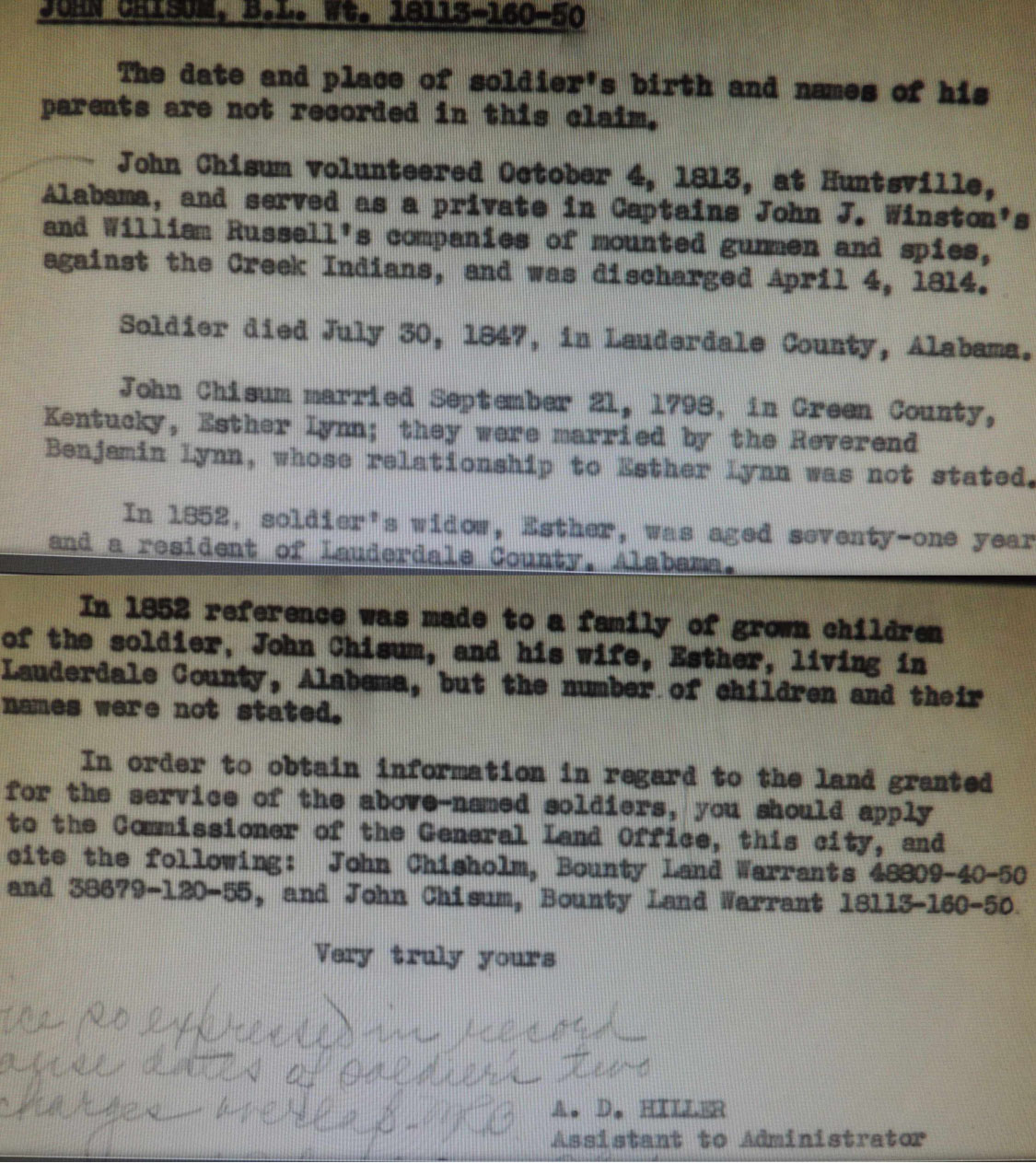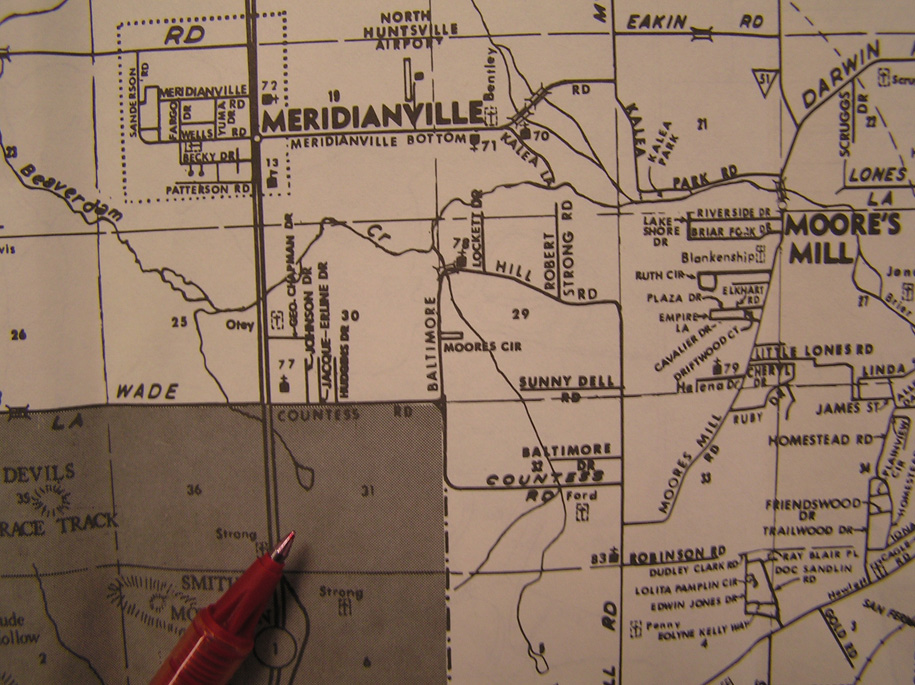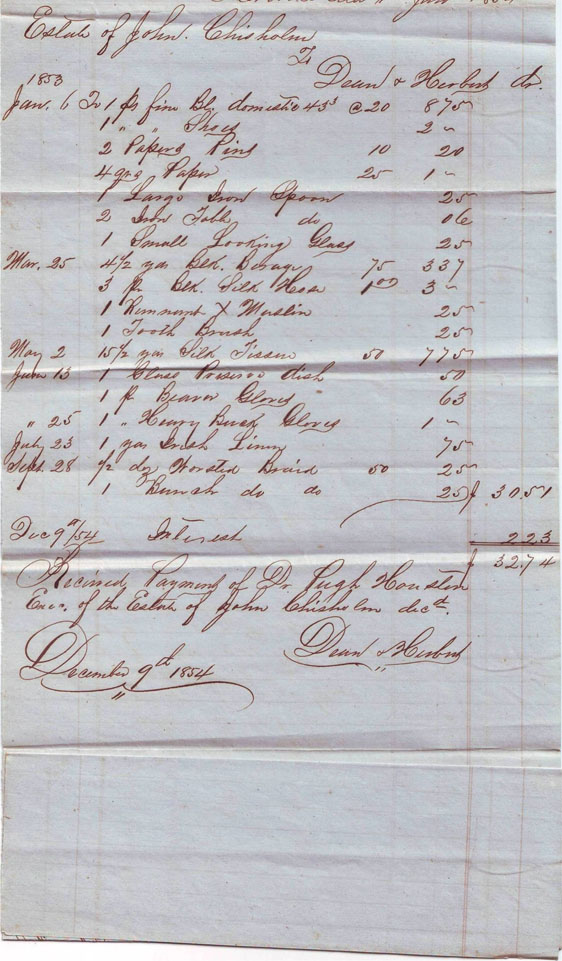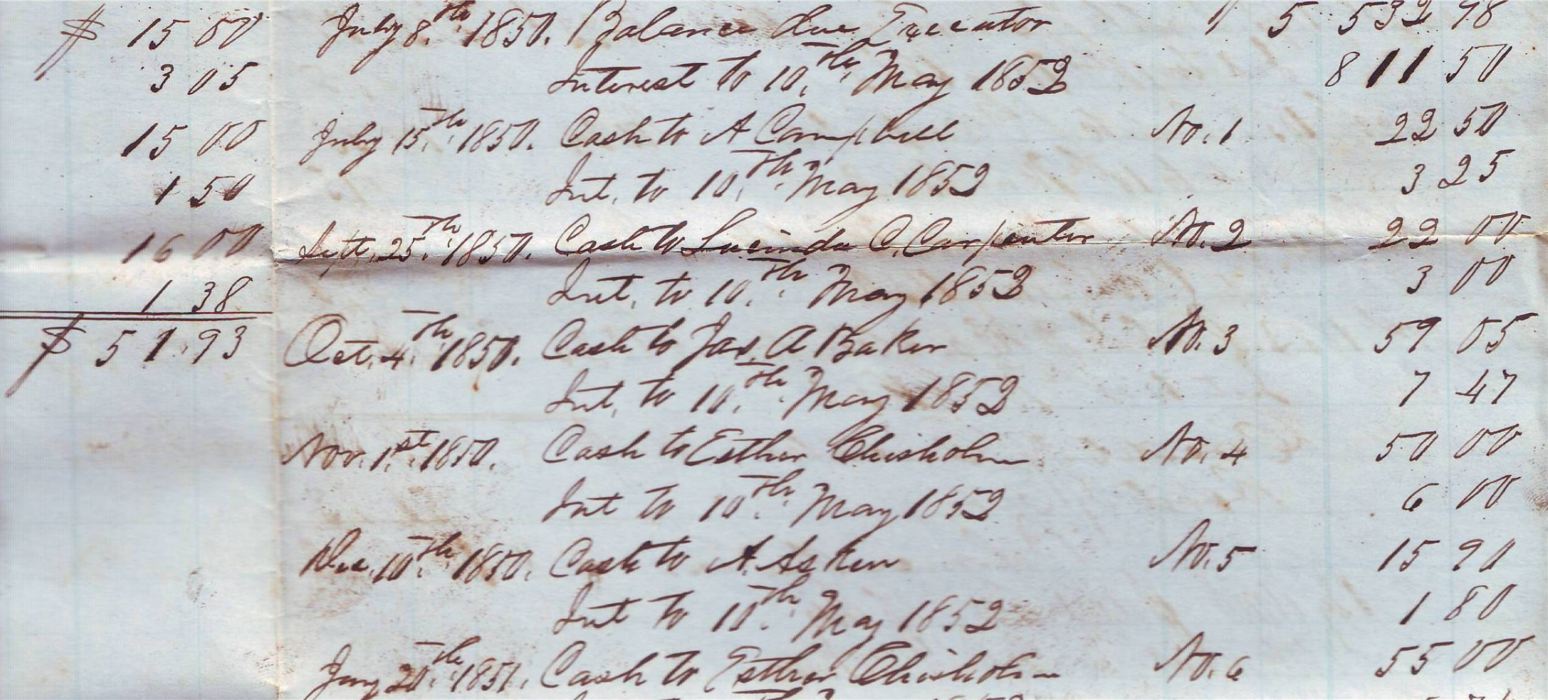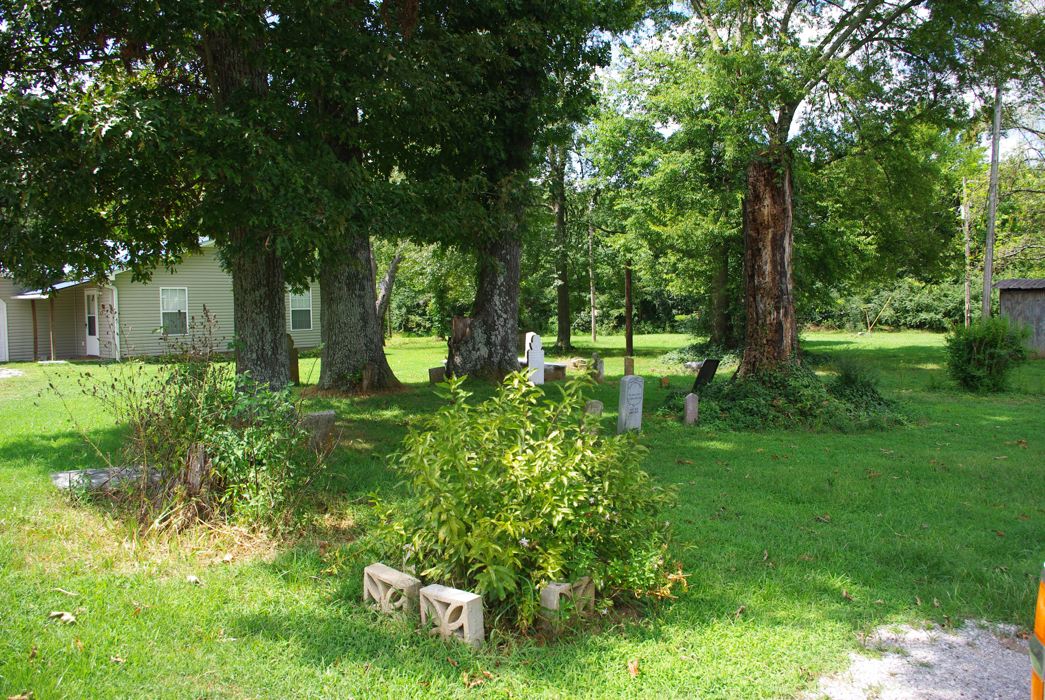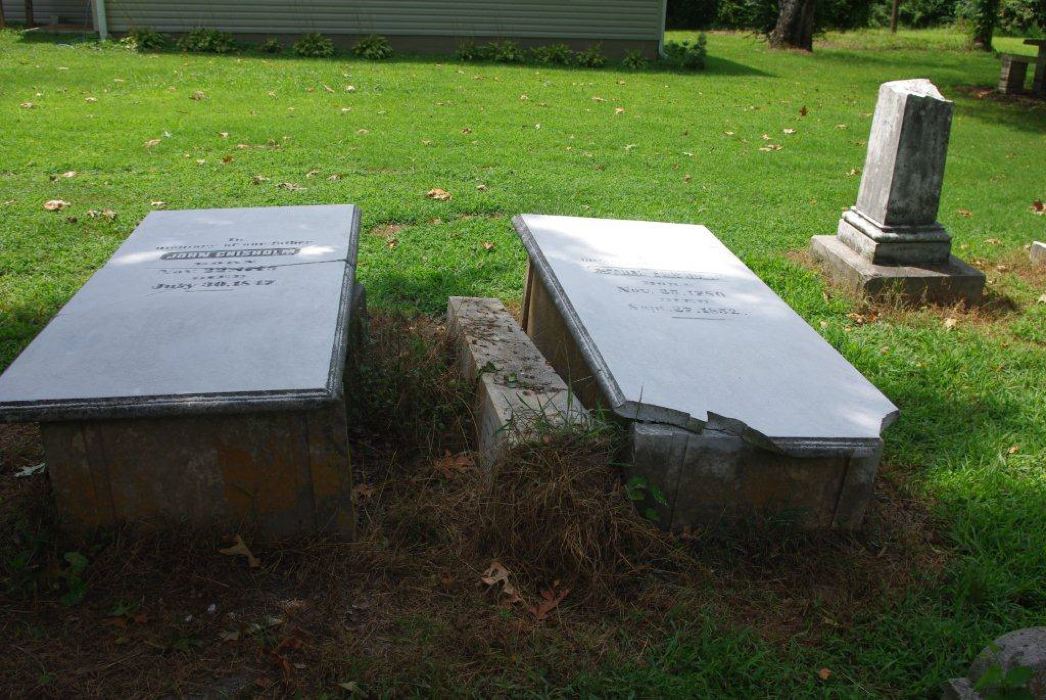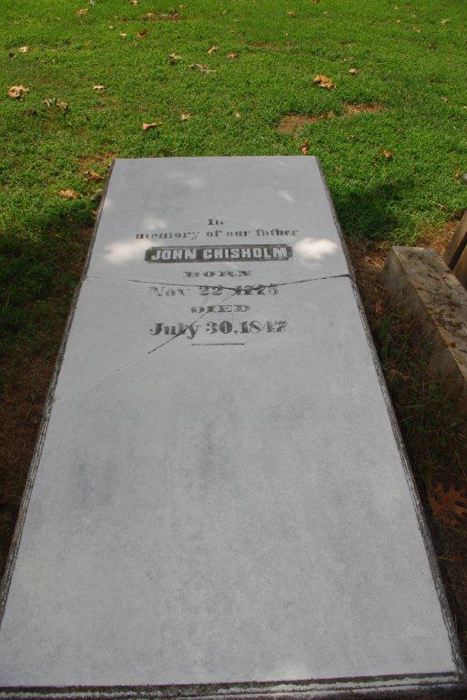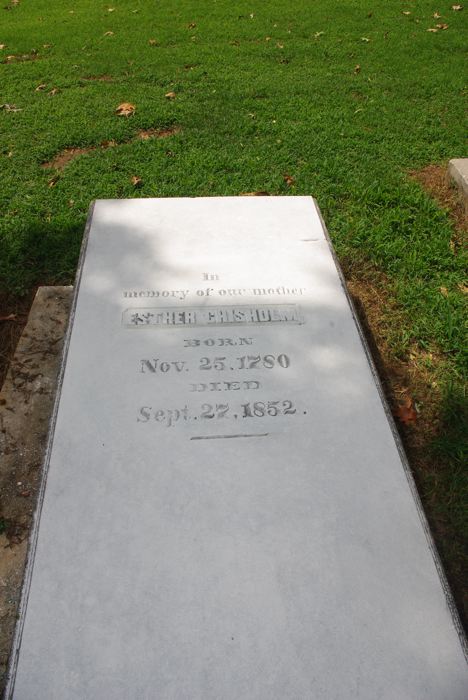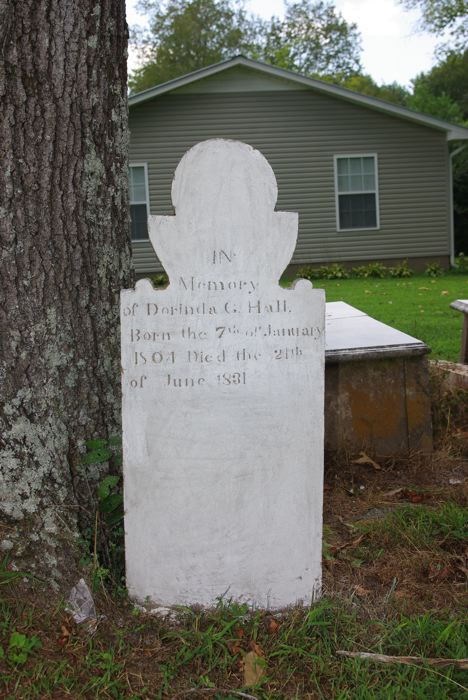John & Esther Chisholm
Early 19th Century
![]()
John And Esther Chisholm And Their Family And Some Schools In Texas
A gospel preacher named Benjamin Linn and his wife had two daughters, Esther and Rachel.
Esther married John Chisholm. They are buried in Chisholm Cemetery near my home which is near Florence, AL. Their daughter, Dorinda married B. F. Hall a prominent gospel preacher. Dorinda is buried beside her parents in Chisholm Cemetery.
Rachel Linn married Marshall D'Spain. He is buried near Waterloo, AL, which is about 20 miles west of Florence. In 1835 the widowed Rachel and her children went to Texas with a group. They employed David Crockett to guide them on their journey to Texas, but he only went to Memphis, TN with them which is about 130 miles west of Florence, AL. He abandoned them because they rested and worshiped on Sundays. They were members of the church of Christ. David Crockett did not want to lose the time for the rest and worship. Had he gone on with them, he might have obeyed the gospel, and he might not have been killed at the Alamo!
This group did go on to Texas. They settled for a while in Clark County, Texas and started the church meeting there. After the Mexican War, people in Clark County, including the church of Christ scattered westward looking for land. Rachel Linn D'Spain's daughter, Hettie married Joseph Clark in Texas. They had two sons, Addison and Randolph.
Charles Carlton established a private school at Kentucky-town near Bonham, Texas in 1866. It was moved to Bonham in 1868 and known as Carlton College.
Two of Carlton's earliest students were Addison and Randolph Clark. They opened a school at Fort Worth, Texas in 1869, which did not continue very long. In 1873 they took over the failing Thorp College on Mr. Thorp's property at Thorp Spring, Texas about 40 miles southwest of Fort Worth. They named it Add-Ran College in memory of Addison Clark's infant son who had just died.
Add-Ran College opened in the fall of 1873 with 13 students.
In 1889 Addison and Randolph Clark gave the Add-Ran College property to the Christian Churches of Texas, and the name was changed to Add-Ran University.
The Female College in Waco, Texas was closed in 1895. Its $115,000 property was offered to Add-Ran University on the condition the school would transfer. The move was made and the school was renamed Texas Christian University which is now located in Fort Worth, Texas.
A small school remained in Thorp Spring which was named Jarvis Institute, then it was named Jarvis College, and after that it was named Add-Ran Jarvis College. It went digressive. The Board of this college agreed to sell to loyal brethren who bought it and opened a new school in 1910, which they called Thorp Spring Christian College. Evidently, this college was closed about 1930.
The information in the first five paragraphs in this treatise is based on research done by one of my former church history students. He is Wayne Kilpatrick and has been teaching church history at International Bible College (recently changed to Heritage Christian University) for several wars.
The rest of the information is from The Search for the Ancient Order, Volume III, by a friend of mine, Earl Irvin West who is a great church historian and faithful gospel preacher.
Some of the gospel preachers who were students at Thorp Spring Christian College that I knew and heard preach were: A. R. Holton, Frank L. Cox, Don Morris, Foy E. Wallace, Jr., and Thomas Reginald Boley. All of these are dead. Don Morris was president of Abilene Christian College when I was a student there in 1949 and 1950. Frank L. Cox was editor of Minister's Monthly and I was on his staff of writers. Thomas Reginald Boley baptized me September 1, 1941. For several years he wrote for The World Evangelist.
-Basil Overton, The World Evangelist, August, 2001, page 3
![]()
The Church In Lauderdale County
1822-1860
In the years that followed the close of the War of 1812, an influx of thousands of settlers came into the northern part of Alabama from Tennessee, North and South Carolina, Georgia, and Virginia. With each new settler came his own peculiar religious views, resulting in the founding of churches in order to propagate their views. Along with these settlers from the older states came the views of Barton Stone, James O'Kelly, and a few years later, Alexander Campbell. Just as with other religious groups, the followers of Stone, O'Kelly, and Campbell founded congregations of believers, who were dedicated to spreading the message of the Restoration Movement. Many of these congregations would prosper for a few years and then gradually disappear. Some, however, would weather the storms of time and exist down to the present.
In northwest Alabama, three such congregations have managed to endure; all having begun previous to the Civil War. Several other congregations in this area were not durable. Many of them have faded into obscurity. This portion of Alabama under consideration consists of Lauderdale, Colbert, and Franklin counties, lying at the extreme west end of the Tennessee River Valley in Alabama; Lauderdale lying north of the Tennessee, Colbert lying to the south, and Franklin lying immediately to the south of Colbert. Their histories, both political and religious, have tied them together in times past. Much has been written about the political history of this area, but very little has been written about the religious history. Hardly anything has been written concerning the Restoration Movement in northwest Alabama. F.D. Srygley's biography of T.B. Larimore, Larimore and His Boys, sheds some light upon the history of this area and George and Mildred Watson's History of the Christian Churches in the Alabama Area gives some insight into this part of the state. Several histories of local congregations have appeared, but many times these works are weighted down by local traditions, rather than historical facts. Due to the lack of knowledge on the part of the average church member concerning the Restoration Movement, the purpose of this study is to give a historical account of the movement in this area. Our method shall be to discover who founded these works and what causes them to grow or die, whichever the case may be.
Since every historical work must have a beginning and an end, we have set the date of our study to begin with 1816, the year John Chisholm's family near Cypress Creek, and to end with 1861, the year the Gospel Advocate ceased being published, due to the Civil War. This time span covers nearly forty years of history in Alabama restoration history. It should be remembered, however, that this is in no way a complete history, because there are examples of churches, such as Liberty, which appeared in The Christian Register of 1848 as being located in Lauderdale County, Alabama, having eightyfive members, and possessing their own house of worship, then disappearing from all written records. Such incidents render it impossible to compile a complete history. History, however, does not dwell upon that which has been lost, but rather that which can be found.
This historical study shall be based upon only that which can be found. In order to prepare such historical undertaking, many sources were consulted. Local newspapers of the period under discussion, local courthouse records, journals of historical societies, unpublished histories and biographical sketches have been a valuable source of material. Several books written by our brethren on subjects not directly related to the Alabama area, yet touching upon it, and literature by other religious groups have proven helpful. Some historical collections of the brotherhood have rendered valuable aids in this investigation, but the chief source of material has been found in brotherhood journals beginning with Campbell's first issue of The Christian Baptist in 1823, through most major journals until the year 1861. Where occasion has demanded and opportunity has afforded, different portions of northwest Alabama have been visited and much valuable information has been gained by private conversation. Such were the sources form whence this history is derived. It is hoped that this uncovering of information will give a better understanding of the Churches of Christ in northwest Alabama.
LAUDERDALE COUNTY 1816-1861
The history of the Stone movement began in Lauderdale County, Alabama, almost parallel with the history of the state. Alabama had scarcely gained statehood (1819) before the influence of Stone and O'Kelly was felt. These brave pioneers came into a wide and fertile valley created by the mighty Tennessee River as it made a large bend across northern Alabama. This was the beautiful Tennessee Valley. They followed the river from Huntsville westward to the foot of the Shoals near where the Natchez Trace crossed the river. Here lay the newly formed town of Florence, Alabama. Florence, being located at the foot of the Shoals and at the head of the navigable waters of the Tennessee, was destined to be a trade center for northwest Alabama.
John Chisholm and his family moved to this area, near Cypress Creek in 1816. The exact month is unknown. It was, however, early in that year. At the same time Marshall D'Spain and his family moved to the Waterloo area. The Chisholms and D'Spains had moved to Lauderdale County, Alabama seeking fertile new land. Chisholm and D'Spain were sons-law to Benjamin Lynn who had established the Church in Huntsville, Alabama. Lynn died in 1814 and never got to move to Lauderdale County with the rest of the family. Lynn had baptized several near Huntsville, thus the Church was of fair size when these families moved westward. The entire congregation made this move. Some of the families moved near Florence and some to Waterloo. Two congregations of the Lord's Church were established immediately, in this northwest Alabama County. The Cypress Creek congregation would prove to be the permanent work.
It was to this booming area that Ephraim D. Moore, the first "Stonian" preacher, came in late 1823. Moore was born in North Carolina in 1782. Later he moved to Tennessee where he became a Christian. He served under Jackson at the Battle of New Orleans as a mess cook. In 1823 he came to Alabama. B.F. Hall wrote: He either taught school or labored on his farm for a number of years, during the week, and preached on Lord's days. Moore had settled in a small village on Cypress Creek about seven miles north of Florence known as Brandon Mills. It was here in the small Cypress Creek community that Moore met young Tolbert Fanning for the first time. Several years later, upon Moore's death, Fanning wrote: We are more indebted to our deceased Brother, E.D. Moore, for our early religious instructions and impressions than to any other man, dead or alive. Our candid judgment is, that we never saw anyone so careful to teach, particularly young persons in the Christian religion. . . As a teacher of dignity, and elevation of style, we are not sure we ever saw superior. In affections and tenderness of heart, he more favorably impressed us than any man we ever saw; and as a lover of the truth, he had no superior. Moore's love of the truth manifested itself in many works; one of them beginning here on Cypress Creek. It was about the time that Moore began preaching in this little North Alabama village that the Republican congregation began to move forward. In 1831 James E. Matthews, who came to Republican in 1826, wrote Simon Clough, editor of The Gospel Luminary, saying: When I came to this county, something over five years ago, there was one small church of about 10 members . . . thus, indicating that the work at Republican was still alive in 1826, yet had not been in existence long enough to have grown to a large membership. The work at Republican progressed rather slowly during 1825, possibly due to Moore's having to teach and farm during the week and only allowing himself time to preach on Lord's Day. Moore, however, did not let his work keep him from teaching the young people or performing an occasional wedding in the community. Help arrived in 1826 with the coming of James E. Matthews.
Exactly what time in 1826 Matthews came to the Florence area is unknown, but in November he was listed as an agent for The Christian Messenger in the Florence area. Matthews was born in Kentucky in 1799. Early in life he became acquainted with the views of Barton Stone and was obedient to the gospel. In 1826 he began preaching and soon came to North Alabama to work. He labored in Lauderdale County over ten years before leaving for Mississippi. Brother Matthews was a vivacious young man when he arrived on Cypress Creek. This vitality, which he possessed, soon began to pay. In 1826 a burst of excitement came with the arrival of B.F. Hall, Matthew's friend, at Republican. It was during this meeting that Tolbert Fanning was baptized "for the remission of sins." By the end of March 1827, Matthews reported: We have lately had a very reviving season. Last Saturday and Lord's day, eight persons were added to the church, and in a few months past, sixteen have professed faith in Christ. By the middle of October that same year, Moore reports: We have just closed our camp meeting. . .Many were there on Thursday, and continued until Tuesday 12 o'clock, and with reluctance, left the encampment. . .the glorious consequence was, that forty professed faith in Christ, and 26 were baptized strait way - 15 or 20 more have expressed their determination to obey the Lord in his ordinance, at our next monthly meeting. . .The good work is moving on in almost every direction. We anticipate happy seasons. One can almost feel the enthusiasm that Moore felt when reporting this work. Because of Moore's renewed enthusiasm and Matthew's already existing enthusiasm, Republican could only grow. Republican was now a pulsating force in the Restoration Movement.
It would have been about this time when B.F. Hall came back in this area preaching "baptism for the remission of sins." Hall had already been in North Alabama from the spring of 1824 until the spring of 1826. He came back in the fall of 1826 and stayed until spring, 1827. One must keep in mind, how ever, that Hall was not preaching "baptism for the remission of sins" during his first work in north Alabama, which was from spring 1824 until spring 1826. It was in the spring of 1826, while on his way back to Kentucky,, that Hall stopped at a Brother Guess' cabin on Line Creek, which ran between Tennessee and Kentucky. It was here that Hall read Alexander Campbell's debate with W.L. McCalla and for the first time in his life he understood that baptism was for the remission of sins. Hall explained: I found the keystone of the arch. It has been lost a long time. I had never seen it before – strange that I had not. But I had seen the vacant space in the arch a hundred times,and had some idea of the size and shape of it; and when I saw baptism as Mr. Campbell had presented it, I knew it would fit and fill the vacant space. Hall began preaching this idea on baptism to everyone who would listen. Hall found eager listeners when he came to Republican.
Hall was set on preaching this New Testament doctrine when he came to Cypress Creek and he did. For the first time the congregation at Republican felt the influence of Alexander Campbell's teaching on the New Testament doctrine of baptism for the remission of sins. Hall delivered it in a plain and simple manner, yet, so effective. When he extended the invitation, he asked the congregation to sing an "invitation" hymn which was sung for the first time among these people. Fanning came forward and made the good confession. B.F. Hall says Fanning was baptized the next morning by James E. Matthews for the remission of sins. The preaching of Hall had been so convincing that he persuaded Matthews to embrace this doctrine. Upon Hall's insistence, Matthews wrote three articles on the subject, which were printed in The Christian Messenger of 1829. These articles seem to be the first full length articles ever written on the subject of baptism for the remission of sins by any of our brethren, Campbell included. Matthews, like Hall, was now convinced that the doctrine was correct and devoted the remainder of his life to spreading it. In 1831 he wrote Simon Clough concerning this doctrine: The doctrine of baptism 'for remission of sins,' generally prevails, but in a More qualified sense than it is held by Alexander Campbell, Editor of the Millennial Harbinger. Matthews had been exposed to the writings of the Millennial Harbinger as early as 1830. Several of his friends were listed in Campbell's "Ledger," as having subscribed to the Harbinger in 1830, and Matthews, himself, was listed by 1831. His reading of the Harbinger placed him in a position to say whether his views or Campbell's were "the more qualified." Just to what extent the views of Campbell had been spread throughout northwest Alabama is reflected in a resolution adopted by the Muscle Shoals Association in 1830. The resolution read as follows: Through Campbellism we see the divine operation of the Holy Spirit either disavowed or so obscurely avowed, as to amount to disavowal. We see experimental religion ridiculed and reprobated. We see the apostolic mode of ordaining ministers, by the laying of hands of the presbytery, ridiculed and condemned. We therein see baptism presented as producing a change of heart and pardon of sins, when the Holy Spirit can alone produce a change, while baptism shows our faith, satisfies our conscience, adopts us into His church and makes us one with Him, by thus fulfilling all righteousness, a change of hearts being previously affected by the Holy Spirit. We therein see, as we awfully fear, an effort by man to pull down the old order of faith and practice taught by our Lord and His apostles, and establish on their ruins a new order and a new name styled Campbellism. From this time forward the Muscle Shoals area, especially Republican, faced stiff opposition form the Baptists. In spite of this opposition, Matthews and Moore made increasing gains, not only at Republican, but throughout all of Lauderdale County. Matthews, having moved westward from Cypress Creek into the community of Bartons, wrote that there were upwards of 200 at Republican and that he had planted a church of about 60 members in his own immediate vicinity. The strength and influence of Republican caused it to be the site of a Christian Conference in 1830. A detailed description is given by Matthews: At Republican, Lauderdale co. (sic) Ala. (sic) The Brethren assembled in conference. Several subjects of interest were considered, among which was the ordination of Elders in every church. It appeared to be almost unanimous opinion of the brethren, that if our churches were on apostolic ground they would have Elders, or men of age experience. . .set apart in every church as Bishops, or overseers, whose duty it should be to exercise discipline, administer the ordinances, and assemble the churches frequently, so that in the absence of the preacher or evangelist, the churches might be kept organized.
With this decision, not only Republican, but all of the churches across north Alabama were taking a giant step toward the restoration of New Testament Christianity. The steps were slow, but each step was deliberate and was placed upon solid ground – the Word of God. Another step was taken in the next conference which began the last day of September in 1831 at Republican. This time the brethren decided to dismiss all of the usual formalities and call no one to the chair, nor choose a President for the meeting. Matthews says: We entered no resolves upon our minute book, nor did we take the name of an "Advisory Council." But "with one accord, in one place" we mutually engaged in arranging the appointments for our next annual meetings, so as to best promote the cause of the Redeemer. . . With the proceedings in this conference the brethren in North Alabama had taken a monumental step toward completely abandoning any human organizations. No doubt this very act in 1831 helped shape the thinking of the brethren in this area concerning societies.
The next conference, which was held at Republican in October of 1832, reflected the changing attitudes of the brotherhood toward conferences. Only ten persons were baptized, and Matthews stated: ". . .prospects were not so flattering as formerly." It seems, also, that a question had arisen over baptism being made a test of communion. Up until this time, the practice at Republican had been to let all denominations partake of the communion. Men such as Moore and Matthews were of the opinion that such act was scriptural. They felt that by allowing the denomination to commune with the Christians, they could win them to the truth by "speaking the truth in love."
Things seem to have improved somewhat during 1833. Matthews reports in a letter to the Messenger dated August 8, 1833, that eight persons had been added and again on September 3, 1833, he reported 30 had been added. He states:. . . the churches in Alabama are gradually increasing, and the prospects brightening. The preaching brethren are becoming alive to the work.
The next Christian Conference was to be held in Lauderdale County beginning on the second Lord's day in August of 1834, the last four having been there, also. The mainstream of the restoration in north Alabama had, by this time, focused on Lauderdale County, and Republican in particular. But all of this was soon to change. E.D. Moore had already moved to Texas sometime during 1832, and James Matthews was having to attend all the churches in Lauderdale and Limestone counties. Matthews had already complained of having "a broken constitution" and "fasting declining health." He had also, by now, begun to center his Lauderdale County work around the western end of the county toward Waterloo. This is evidenced by the fact that Barton Stone had sent several songbooks to Matthews through the Waterloo Post Office in January of 1833. The facts are not exactly clear concerning the work at Waterloo, but it seems as though a work had been established there at this time.
Even though by now Matthews had centered his work around Barton's and Waterloo, the Republican work continued to thrive. James Young was emerging as a prominent figure at the Cypress Creek work. He had been ordained as an evangelist sometime after the 1830 Christian Conference in which it was decided to ordain elders and evangelists in every congregation. By August of 1834, Young was the agent for the Messenger in the Florence area. Several members were now taking the Christian Messenger in this area at this time. Several members, including Young, were subscribing to the Harbinger, also. Subscriptions to the brotherhood journals indicate an interest in one's spiritual condition, as well as an interest in what was going on in the brotherhood. Such was the attitude of the membership at Republican during the mid 1830's.
In March of 1836 James Matthews describes the condition of the church throughout north Alabama as "being rotten to the core" and being in need of "radical reform." He writes: I cannot but believe that impending vengeance is hanging over our guilty land. The retributive justice of the Almighty will not sleep, nor be withheld forever. Perhaps Matthews' constitution having been broken and his ill health helped shape this dismal picture of the Alabama work. Brother James Young gives another picture entirely in his letter of October 23, 1836. He states that the church at Florence (Cypress Creek) had five additions and that the prospects for the Florence work was "good." He goes on to report nine baptisms elsewhere. According to Young, the church was still growing at Republican. One thing that did help retard the growth at Republican, as well as elsewhere in north Alabama, was the fact that Christian Conferences were no longer held, or if so, no mention of them can be found after 1834. Camp meetings were still held, but they did not draw the crowds in the capacity that the conferences had drawn them. This was a visible sign that the work was slowing down. Another thing that probably hurt the work in this area was that by 1835, Stone had moved his Messenger to Jacksonville, Illinois, and was giving more attention to the work in Missouri and Illinois. Alabama no longer had a prominent place in the Messenger. Stone's publication seemed to have been the "chord" that bound the north Alabama brethren together. Once the Messenger was removed, the work in north Alabama seemed to be retarded, especially in Lauderdale County. The brethren needed a new motivating force in the form of a journal. The Harbinger was being read by many Lauderdale Countians, but was looked upon by many as being too harsh toward the denominations. Matthews expressed the sentiment of most north Alabama brethren when he compared The Christian Messenger to the works of Alexander Campbell. He wrote: "I think the latter have too much severity attached to them." The brethren believed the truth was to be spoken "in love." Apparently, they felt Campbell did not always speak in this manner. The search for something to replace the Messenger and its influence is evidenced by the names of many north Alabama brethren which appeared in other brotherhood journals, such as Walter Scott's Evangelist and D.S. Burnet's Christian Preacher. It was not until Tolbert Fanning's Christian Review appeared in January of 1844 that the problem was solved. By Fanning having come from this area, it was felt that once more the work in north Alabama would receive the proper attention. It now had been over nine years since the Messenger had dominated this area. Many changes had taken place in Lauderdale County during these nine years.
By 1844 Matthews had moved to Mississippi and had become involved in politics. The works at Bartons and Waterloo were on decline and were doomed to eventually disappear completely. Dr. W.H. Wharton, from Tuscumbia, made an unsuccessful attempt to establish a work in the Middle Cypress community (Bethel Berry) in 1838. During this meeting, five persons were baptized, one being John Ijams, the grandfather of our beloved E.H. Ijams. Several years later, a young gospel preacher fresh out of Franklin College, by the name of T.B. Larimore helped organize a permanent work in this same community. Republican was slowly undergoing a name change during the late 1830's. The name was being called Old Cypress. This name remained until the middle 1850's when it began to be called Stoney Point. The Cypress Creek brethren were still meeting in a campground, a huge clearing with a brush arbor. The absence of a building for the brethren is evidently shown by the fact that when Tolbert Fanning visited his old friends in this area in 1842, his preaching had to be conducted in a Methodist meeting-house. Fanning again had to secure the use of the Methodist building on November 2, 1844.
Here, after greeting some of the preachers of the north Alabama area and many old friends, he preached for three days of "the first principles of Christianity." James Hackworth and James Young were two of the Lauderdale County preachers who attended this meeting. For some time the burden of spreading the message of the Gospel in this country had been solely upon Young and Hackworth. Hackworth admired Fanning greatly but would not hesitate to disagree with Fanning when the occasion arose. One such instance is illustrated by Hackworth after Fanning had alluded to the establishment of the church in Russellville, Alabama, as being providential. Hackworth wrote: I am of the opinion that your pen rather slipped when you said the gathering of the church at Russellville was a providential thing. It seems that he never agreed with Fanning upon this point, but it never ended their friendship. Later, Hackworth developed some rather strange views concerning the Holy Spirit and again he and Fanning disagreed. During the time Hackworth was at the church on Cypress Creek, he wrote concerning the state of the congregation there:
We are in a tolerable state of spiritual health. We meet weakly (sic) and break the loaf, sing praises, teach and exhort poor sinners to obey our blessed Lord and we are often much refreshed. In spite of the continuance of weekly meetings to "break the loaf," "sing," and "teach," and "exhort," the past glory of the Cypress Creek work was fading. In 1848 its membership was only 67; however, they had by now secured a meetinghouse near Cypress Creek that faced the south, standing in front of a post oak tree, and was entered from the south end. There was only one other meeting-house in the county owned by our brethren at that time. The congregation at Liberty boasted of having their own meetinghouse and a membership of 85 souls. James Young was minister to the Liberty and Blue Water churches; Blue Water having only 13 members. Both congregations have long since passed from the pages of recorded history.
J.M. Hackworth was now gone from Old Cypress leaving it without a regular minister. James Young was still living in the community, but he was preaching for several congregations, both in Lauderdale and surrounding counties. With the coming of the decade of the 1850's, the work here was on fairly good footing. The burden of keeping the flock together fell on the eldership, which was composed of P. Gresham, C.W. Wesson and Andrew J. Grisham (probably Gresham) and probably others. An J.M."Matt Hackworth occasional visit from Brother J.H. Dunn of Limestone County helped to keep the congregation revived.
In the summer of 1851, one such period of revival came J.H. Dunn and J.J. Trott came to Old Cypress in early July and worked with the brethren for seven days. This resulted in seventeen confessions and one restoration. The brethren had "all things in common," sharing both their joy and their food. Trott referred to their eating together as a "basket meeting." He describes the feeling during this time by writing:
They manifested zeal and Christian hospitality of the primitive disciples in 'having all things in common' and being of 'one heart and soul.' The feelings experienced during this meeting, no doubt, reminded the older brethren of days gone by when "Old Republican" was the pride of the north Alabama brotherhood.
By this time, brethren in the Tennessee Valley were relaxing their feelings somewhat towards some sort of cooperation among the churches, especially in evangelization, but not without some opposition. By 1850 they were planning on having a cooperation meeting at Green Hill in Limestone County. Tolbert Fanning was to attend. Either the meeting never materialized or it was a complete failure, because Fanning never printed anymore in his Christian Magazine concerning the meeting. Some of the churches joined in with the Tennessee Evangelizing Association the next year. J.H. Dunn was the "State Evangelist of North Alabama" in 1851, and only received $208. for that year's labors. The blame for such a small amount of pay was: The committee upon Evangelizing never received any funds for Alabama, and at our late state meeting there was no representation for that state. Their connection with us seemed more formal than real.
By June of 1852, James Young of Florence and David G. Ligon of Moulton were placed on the Board of Directors for the Tennessee Evangelizing Committee. This shows that some of the brethren , at least, were now interested in seeing the preaching conditions in their area remedied. By September, the north Alabama area had in mind to try another cooperation meeting at Green Hill in Limestone County. Again, nothing much was ever reported on the outcome of this organized effort. It seems that many brethren were still skeptical of this type of cooperation. James Young's involvement in the Tennessee Evangelizing Committee may indicate, however, that the Cypress Creek brethren were in favor of some sort of cooperation, because by October 27, 1860, the Stoney Point, Old Cypress congregation, had sent two of its elders to the cooperation meeting in LaFayette County, Alabama.
During the organization attempts of the 1850's, several preachers visited Lauderdale County; some to preach and some for other reasons. In April of 1852, J.B. Ferguson came to the resort community of Bailey Springs, about eight miles east of Florence, apparently to recuperate from some illness. He wrote concerning himself: "We have been communing with the deep spirit of affliction. . ." J.H. Dunn and John Taylor visited the county many times during this period and helped keep the churches alive. Brother Dunn wrote concerning one such visit in 1856: I visited Old Cypress - now called Stoney Point - Lauderdale County, Alabama, and held a meeting of three days continuance, including the Lord's day in last month (November), at which time we had three additions by confession and baptism. The dropping spirits of the brethren and sisters were much revived during the very pleasant interview. By 1858, Dunn was writing:
The cause of primitive Christianity progresses slowly in North Alabama, owing the scarcity of proclaimers of the ‘pure testimony of God.' In the same letter he reported only one addition at Stoney Point during that preaching engagement. The next month he reported three more additions. John Taylor's work was about the same as J.H. Dunn's work. Taylor writes: I attend the congregation at Stoney Point, in Lauderdale County once a month, and have thus far made fourteen additions. In this letter Brother Taylor gives an insight into the congregation's condition at this time. He states: This congregation now numbers over one hundred, meets every Lord's day, and are in a prosperous condition . . In this same letter, he says the brethren at Stoney Point were expecting Tolbert Fanning to come and spend a week with them. Fanning was already, at that time, preaching across north Alabama. The same year (1860), Fanning was on his north Alabama visit, the cooperation meeting was held in LaFayette county. George L. Brown was selected to be state evangelist for Lauderdale, Limestone, and Franklin counties, for the year of 1861. At this time, Stoney Point had contributed one hundred dollars to the evangelizing association and was reported to have a membership of 58. Richard James, in an unpublished thesis, reported 60 members at Florence Stoney Point at this time. John Taylor had earlier reported that the congregation "numbered over one hundred," but this figure, no doubt, reflected the number of young children and non-members in attendance there. It seems that the brethren in Lauderdale County were coming into the Civil War period on relatively weak footing and one would wonder if they would survive the coming crisis. Sadly to say, very little has been said concerning our Lauderdale County brethren during the war.
The Civil War brought to a close a glorious period of the Restoration Movement in Lauderdale County. From its beginning in 1824 down to 1861, the work here had been blessed by many great "workers for the Master." Preachers like E.D. Moore, James E. Matthews, James Hackworth, and James Young, who worked on a permanent basis, and men like B.F. Hall, Tolbert Fanning, J.J. Trott, J.H. Dunn, John Taylor, and other itinerant workers, all made a lasting impression upon this county. They helped mold its basic beliefs, which have been handed down to the present. Preachers are not the only people who make up a work, however. It would only be fair to mention some of the other citizens of the Lord's Kingdom, who helped carry the work in the county. General Leroy P. Walker, a member on Cypress Creek, served as a circuit judge in the early days of Alabama history. Fanning said of General Walker's wife, upon her death: She was brought up in the midst of prosperity and affluence, and she was one of the very few, who regarded the 'reproach of Christ,' of greater value than gorgeousness of earth. Another member was Dr. John H. Hancock, who was described as:. . . a decided character, both as a citizen, and physician. A tall, fine looking man, bold and reckless in the expression of his views, he was an accomplished physician, and had an extensive practice. Another doctor among the saints at Cypress Creek, was Dr. Gabriel Bumpus, who sometimes was called "Gabe." He is listed in Campbell's Ledger in 1844 as a subscriber to The Millennial Harbinger. Here his name was entered as "Dr. Edward G. Bumpus." Bumpus is described as follows: Of very large stature, weighing about three hundred pounds, very eccentric in Manners and laconic in expression, an excellent physician and a ruling spirit, he Acquired considerable celebrity. He possessed an endless variety of proverbs and never wasted any breath in giving expression to his thoughts. Bumpus lived to be one hundred years old.
Other members who became prominent in the community were men like Dr. Pugh Houston, described as intelligent and a skillful physician, who was a brother to Governor George Houston, and John Chisholm, Esquire, who probably was a lawyer. There are many members who never gained prominent places in the Lauderdale community, but rather gained prominent places in the Lord's community, which after all, was the purpose of the Restoration Movement in Lauderdale County, Alabama.
-C. Wayne Kilpatrick, Alabama Restoration Journal, Volume 1, Issue 2, March 1, 2006, pages 17-22
![]()
John Chisholm's Service Record
-Contributed by Frank Richey
![]()
Directions To The Meridianville Home & Land Of John & Esther Chisholm
John & Esther Chisholm purchased a block of land north of Huntsville, Alabama in 1809. The land today is primarily farmland except for a section which is now a golf course. It is situated on Hwy. 231 between Huntsville and Meridianville. Special thanks to Frank Richey for finding this location in October, 2013.
GPS Location
34.826416,-86.569029
View Larger Map
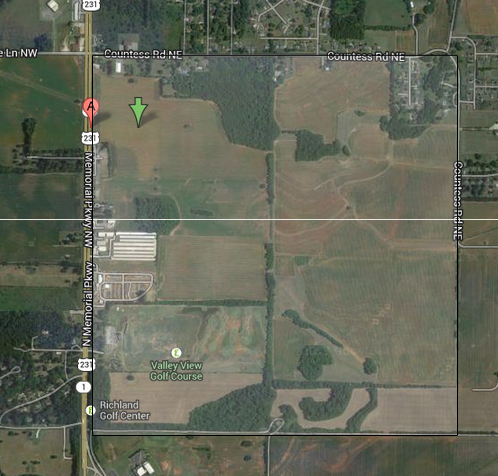
![]()
Excerpts From The Will of John Chisholm
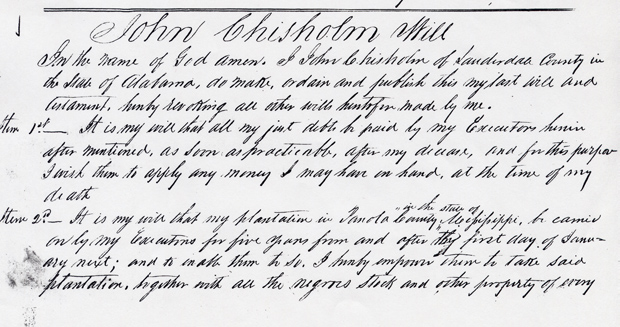
![]()
Out Of My Memories
The names of John and Esther Chisholm first came to the ears of your web editor in the fall of 1986. I was a student at Heritage Christian University, then known as International Bible College. I had taken my first class on Restoration History with my instructor, C. Wayne Kilpatrick. The previous spring I had enjoyed a most gratifying study in World History with brother Wayne, and had followed up this study with a campaign in the summer with him in the British Isles. Being so impressed with his knowledge, when the fall semester arrived, I was eager to hear more of what this man could teach me.
In the early weeks of the study, the common names you would hear was Barton W. Stone, Walter Scott, and Alexander Campbell had come to light several times. However, when local history began to be discussed, the story of Benjamin Lynn began to be unfolded. This great pathfinder, woodsman, hunter, tracker, and all around pioneer was also one of the earliest preachers of the old time gospel in Kentucky. He had requested immersion of Barton W. Stone for the remission of his sins as early in 1805, three years before Alexander Campbell arrived in America.
Further discussion led to hearing of how Lynn and his daughters Rachel and Esther and their husbands and families all moved to Huntsville Alabama as early as 1814. Later as the west began to be open to settlers they were among the first who staked out land in the Shoals region of Alabama, now known as Lauderdale County. Esther's husband John Chisholm and their family settled north of Florence in the region up the Chisholm Highway, named after John Chisholm. Rachel and her husband, Marshall DeSpain moved over to Waterloo in the Northwest Corner of Alabama. After Marshall's death, Rachel was among the group of settlers who went out to Texas in the 1830s and planted New Testament Christianity there for the first time.
One day while when class had begun, brother Wayne told us we were going on a little field trip. We all got into cars and went the six mile distance over to Chisholm Hwy., to where the Chisholms were buried. There behind an old house was a little cemetery, barely kept up by the neighbors where John and Esther, his father John, Sr., and their daughter Dorinda Hall, first wife of Elder B.F. Hall were buried.
This visit brought about some of the first photos I ever taken of monuments of leaders in the Restoration Movement. This cemetery so inspired me as to the work of these people, that my heart was pulled ever closer to the them and the countless thousands of yesteryear who have served the Lord by preaching and teaching the concept of New Testament Christianity.
Many thanks to my good friend, teacher, and mentor, C. Wayne Kilpatrick for his love for history, and his willingness to share it these last many years as Professor of History at Heritage Christian University. Without brother Wayne www.TheRestorationMovement.com would never have been possible.
-Written November 11, 2013, by Scott Harp
![]()
Chisholm Cemetery
GPS Location Of Chisholm Cemetery
34.902626,-87.670673
View Larger Map
From Florence Heading North On Chisholm Highway About Five Miles North Of Florence Is The Oldest Known Cemetery In The State Of Alabama. It Is The Small Chisholm Family Cemetery. It is located Behind A Small House. Most Anyone Out That Way Will Know Where It Is.
The Chisholms Were Some Of The First Settlers Of Lauderdale County. The Pictures Below Are Of The Son And Daughter-In-Law Of John Chisholm. Esther Was The Daughter Of Benjamin Lynn, The Colorful Woodsman From Kentucky, Who Became A Christian Through The Reading His Own Bible And Later Studying And Obeying The Gospel Under The Teaching Of Barton W. Stone.
John And Esther's Daughter, Dorinda Chisholm Hall, Is Also Buried In The Little Cemetery With Her Father And Mother And Grandparents. She Was The First Wife Of B.F. Hall, A Faithful Gospel Preacher Who's Teaching On Baptism Brought True Restoration Of New Testament Christianity To The Wild Frontier.
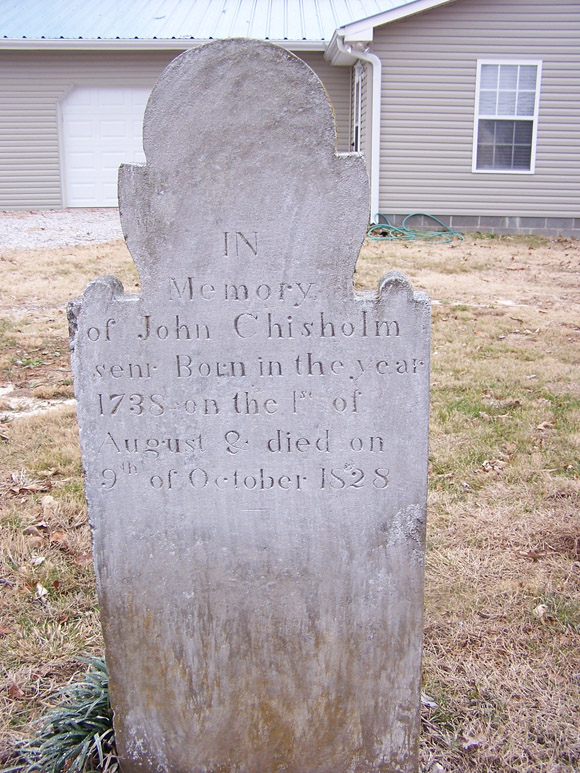
In
Memory
of John Chisholm
senr Born in the year
1738 on the 1st of
August & died on
9th of October 1828
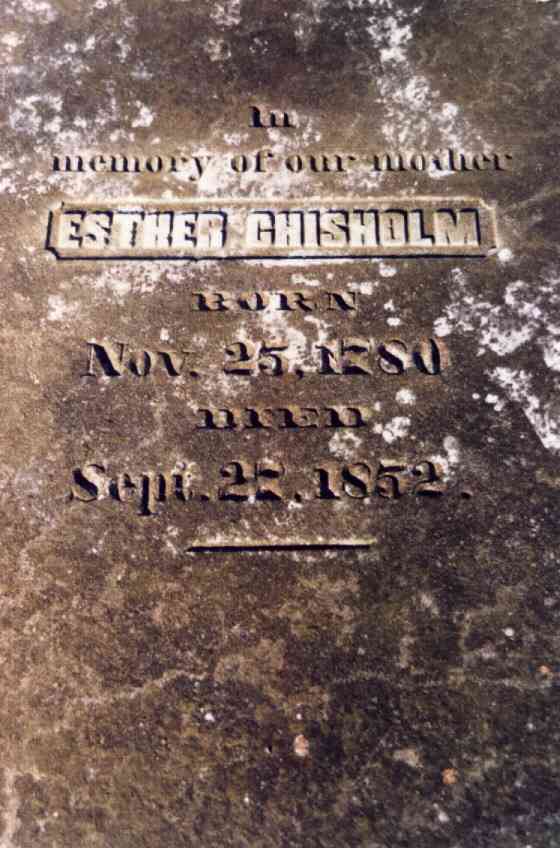
In
Memory Of Our Mother
Esther Chisholm
Born
November 25, 1780
Died
September 27, 1852
Daughter Of Pioneer Preacher, Benjamin Lynn
In Memory Of
Dorinda C. Hall
Born The 7th Of January
1804, Died The 21st Of June 1831
Wife Of B.F. Hall
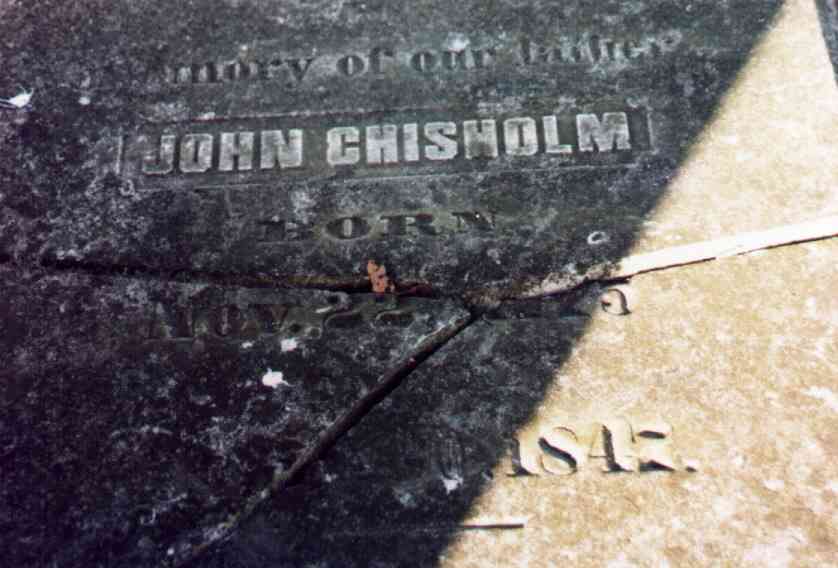
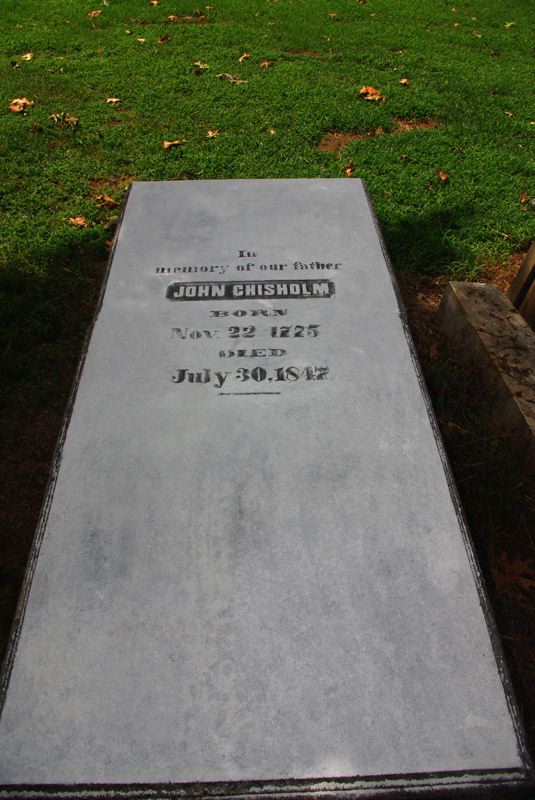
In Memory Of Our Father
John Chisholm
Born
November 22, 1775
Died
July 30, 1847
photo courtesy of C. Wayne Kilpatrick
![]()
Photos Taken in 2011 By C. Wayne Kilpatrick
![]()
Page Produced in November, 2013
Courtesy of Scott Harp
www.TheRestorationMovement.com
Special Thanks to C. Wayne Kilpatick for first bringing to this editor the Chisholm family names. He wrote one of the articles on this site as well as provided grave photos of the Chisholm family cemetery. Thanks also Frank Richey for providing some documentation that is being shared on this site as well as the late and much loved Basil Overton who so loved the history of his home in Lauderdale County, Alabama.
![]()
